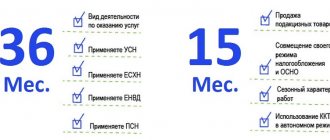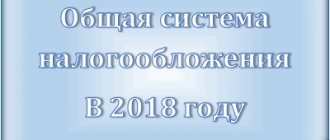If you think that understanding tax regimes is very difficult, then you are not alone, Albert Einstein himself is in your company. The creator of the theory of relativity believed that the most incomprehensible thing in this world is the tax scale. However, if you want to conduct an effective, financially, entrepreneurial activity, you will still have to understand this.
And for those who still have questions or those who want to get advice from a professional, we can offer a free consultation on taxation from 1C specialists:
Free tax consultation
Why is it important to choose the right tax system?
Taxation systems are regimes established at the legislative level for paying taxes in favor of the state by organizations, individuals, and individual entrepreneurs. In this article we will look at the tax regimes that can be applied by LLCs.
If you choose the right tax payment system, you can significantly increase company profits. Since making a profit is the key task of any entrepreneur, choosing the optimal tax system becomes a priority. With the right choice, based on an analysis of the organization’s activities, the volume of tax deductions may become even lower than the personal income tax paid by individuals on wages.
The taxation system is characterized by various indicators. By virtue of paragraph 1 of Art. 17 of the Tax Code of the Russian Federation, each tax is characterized by its elements, namely:
- object of taxation;
- the tax base;
- taxable period;
- tax rate;
- tax calculation procedure;
- procedure and deadlines for tax payment.
If you analyze each of these characteristics in relation to all tax payment systems provided in Russia, you can easily choose the most profitable one.
There are not very many types of modes, and only 4 are relevant for LLCs. These include:
OSNO - this tax payment system is general and is selected by default when an organization begins its activities upon registration.
The simplified tax system is a simplified system that entails a lower tax burden, but is not suitable for all companies.
UTII is a single tax on imputed income. Such a system can be chosen only if the organization carries out certain types of activities.
Unified agricultural tax - unified agricultural tax. Can only be used by agricultural producers.
There is also a patent system for individual entrepreneurs, which LLC cannot choose.
Single tax on imputed income (Imputed income, UTII)
UTII is a preferential type of taxation for individual entrepreneurs and legal entities engaged in trade and provision of services to the public. Imputed income is not received, but potentially possible income.
Advantages:
- the tax base is constant and does not depend on income;
- one tax is paid;
- The amount of paid contributions for pension and health insurance is calculated.
The tax base is calculated depending on the retail space, the presence of employees and other factors. However, it is not necessary to confirm the actual income received.
One tax is paid at rates ranging from 7.5% to 15%.
Weak sides:
- not used for all types of activities;
- There is a limit on employees (no more than 100).
And most importantly, in accordance with Art. 5 part 8 of Federal Law No. 97-FZ of June 29, 2012, UTII should be abolished in 2021.
General taxation system (OSNO)
This system combines three taxes that must be paid: profit tax (income minus expenses), property tax (movable and immovable), VAT (value added tax).
The first tax (income tax) is paid on the difference between income and expenses. At the same time, it is advisable for the organization to confirm to the Federal Tax Service as many expenses as possible, which can be received both from the sale of products and services, and may be non-sales. The second tax (property tax) is paid on assets on the balance sheet. There are many nuances, options for exemption from paying this tax, and benefits. The third tax (VAT) is paid upon the sale of goods, provision of services, and performance of work. It is possible to apply deductions, as well as exemption from VAT in cases specified by law.
Organizations do not pay personal income tax, only individual entrepreneurs and individuals pay them.
When registering, all companies by default begin operating on OSNO, and then can switch to another (if there are no prohibitions on the type of activity, number of employees, profit margin, etc.). The opposite situation is also possible, when an organization is under a special regime, for example, the simplified tax system, and loses the right to use it. In this case, it automatically switches to OSNO.
Due to the fact that three taxes must be paid at once, OSNO is not the easiest system to understand, because it is necessary to calculate each of the deductions, follow the deadlines for payment of payments provided by law, submit the necessary reports, and maintain accounting.
As a general rule, income tax is 20% (there are preferential categories of payers). VAT can be different: 0%, 10%, 18%. The property tax rate also varies up to 2.2%.
What influences the ability to choose a tax system?
There are many such criteria, and among them:
- Kind of activity;
- organizational and legal form - or LLC;
- amount of workers;
- the amount of income received;
- regional features of tax regimes;
- the cost of fixed assets on the enterprise's balance sheet;
- circle of main clients and consumers;
- export-import activities;
- preferential tax rate for certain categories of taxpayers;
- regularity and uniformity of income generation;
- the ability to properly document expenses;
- the procedure for paying insurance premiums for individual entrepreneurs in 2021 for themselves and for employees for LLCs and individual entrepreneurs.
If you want to avoid annoying financial losses, under any taxation system you must first of all properly organize your accounting. So that you can try outsourcing accounting without any material risks and decide whether it suits you, we, together with the 1C company, are ready to provide our users with a month of free accounting services :
Free accounting services from 1C
Absolutely all taxpayers can work on the general taxation system; OSNO is not subject to any restrictions. Unfortunately, this system is the most burdensome in Russia, both financially and administratively (that is, complex in accounting, reporting and interaction with tax authorities).
But for small businesses there are much simpler and more profitable tax regimes, such as the simplified tax system, UTII, Patent Taxation System, Unified Agricultural Tax. Such regimes are called preferential or special, and they allow a start-up or small business to operate in fairly benign conditions. You can familiarize yourself with these taxation systems in detail in separate articles dedicated to them.
To operate under preferential treatment, LLCs or must meet a number of requirements, such as:
| Requirements | simplified tax system | Unified agricultural tax | UTII | PSN |
| Kind of activity | The production of excisable goods (alcohol and tobacco products, cars, gasoline, diesel fuel, etc.) is prohibited; extraction and sale of minerals, except for common ones, such as sand, clay, peat, crushed stone, building stone. Prohibition of use by banks, pawnshops, investment funds, insurers, non-state pension funds, professional participants in the securities market, private notaries and lawyers. For a complete list, see Art. 346.12 (3) Tax Code of the Russian Federation. | Intended only for agricultural producers, i.e. those who produce, process and sell agricultural products. This also includes fisheries organizations and entrepreneurs. The main condition for applying the Unified Agricultural Tax is that the share of income from the sale of agricultural products or catch must exceed 70% of total income from goods and services. LLCs or individual entrepreneurs that do not produce agricultural products, but only process them, are not entitled to apply the Unified Agricultural Tax. Manufacturers of excisable goods (alcohol, tobacco, etc.) also cannot apply the Unified Agricultural Tax. | The following services are allowed: household, veterinary, catering, parking lots, trucking, service stations, etc., as well as some types of retail trade in areas up to 150 square meters. m. (a complete list of activities on UTII is given in clause 2 346.26 of the Tax Code of the Russian Federation). The specified list of activities may be reduced by regional laws. | Certain types of business activities specified in Art. 346.43 of the Tax Code of the Russian Federation, including services and retail trade (as well as catering services) on areas up to 50 square meters. m. This list can be expanded in the regions with additional types of household services for OKUN. |
| Organizational and legal form | LLCs and individual entrepreneurs, except for foreign organizations, government and budgetary institutions and organizations in which the share of participation of other organizations is more than 25% | Only LLCs and individual entrepreneurs of agricultural producers or fisheries. | LLCs and individual entrepreneurs, except for organizations in which the share of participation of other organizations is more than 25%, as well as categories of largest taxpayers | Individual entrepreneur only |
| Number of employees | No more than 100 | There are no restrictions for agricultural producers, and for fishing farms - no more than 300 employees. | No more than 100 | No more than 15 (including the individual entrepreneur himself and employees in other modes) |
| Amount of income received | An already operating LLC cannot switch to the simplified tax system if, based on the results of 9 months of the year in which it submits a notice of transition, its income exceeded 112.5 million rubles. There is no such restriction for individual entrepreneurs. Additionally, LLCs and individual entrepreneurs who received income in excess of 150 million rubles during the year lose the right to the simplified tax system. | Not limited, provided that the share of income from the sale of agricultural products or catch exceeds 70% of total income from goods and services. | Is not limited | An entrepreneur loses the right to a patent if, since the beginning of the year, his income from the type of activity for which the patent was received has exceeded 60 million rubles. |
Here we have provided only the most basic requirements for the application of preferential treatment; for complete information, please refer to the relevant articles on the website.
Get a free consultation
Simplified taxation system (STS): simplified taxation system for income, or simplified taxation system for income minus expenses
The tax system under consideration is popularly called “simplified”. There are two possible options for its application - taxation of income or profit (income minus expenses). The simplified system is called due to the simple procedure for submitting reports and the absence of the need to calculate the amounts of payment of a significant number of types of taxes, such as VAT and property tax.
Tax rates are quite low. Under the simplified tax system, income is applied at a rate of 6%. Moreover, regions have the right to reduce it to 1%. If the simplified taxation system is used for income minus expenses, the tax burden is 15%, but regions can reduce it down to 5%.
When paying, advance payments are applied (i.e. payments “in advance”, in advance). If such a system were not used, the tax would be paid once a year, which would lead to uneven filling of the budget. Thus, payments are made quarterly, at 25%, until the 25th day of the month following the last month in each quarter. Reporting is extremely simplified and consists of only one declaration, which is submitted by March 31 following the reporting year.
To switch to the simplified tax system, you must submit an application for this. The deadline for filing it is within 30 days from the date of registration of the company. If a company wants to switch to the simplified tax system after 30 days from the date of registration, it can submit a notification to the Federal Tax Service before December 31 of the year preceding the transition. For example, if you plan to transfer in 2021, notification must be submitted by December 31, 2021.
What types of taxation are there for LLCs this year?
The articles of the Tax Code of the Russian Federation on “imputation” have lost their force, which has led to the fact that all LLCs registered on the territory of the Russian Federation have lost the opportunity to choose this taxation, as well as to use this type of taxation together with OBSN, the so-called Unified Agricultural Tax or “simplified taxation”. In addition, it led to the fact that LLCs lost the right to combine.
Summarizing all of the above, we conclude that at present, LLCs have three isolated from each other and in no way compatible types of taxation: OBSN, simplified tax system or unified agricultural tax.
UTII
UTII is another taxation system, the peculiarity of which is that it is implemented at the regional level. The second important feature is the possibility of its use only for those types of businesses, the list of which is contained in clause 2 of Art. 346.26 Tax Code of the Russian Federation.
These include:
- domestic services;
- veterinary services;
- repair, maintenance and washing of vehicles;
- activities related to the placement of vehicles in parking lots;
- transportation of passengers (up to 20 vehicles);
- retail trade, if the area of each facility does not exceed 150 square meters;
- catering services (halls where services are provided - up to 150 square meters);
- hotel business, up to 500 square meters for each hotel;
- lease of retail space;
- lease of land plots for trade.
Unified agricultural tax
This type of taxation system is available only to organizations engaged in agriculture, fishing, as well as companies providing services to farmers engaged in crop production and livestock farming. Profit from these areas should account for more than 70% of the total business volume. The closest thing to the Unified Agricultural Tax is the simplified tax system for income minus expenses, since the tax is calculated in exactly the same way, but at a rate of 6%.
Only organizations that are engaged in the production, processing, sale of agricultural products, fish resources, or provide services to organizations involved in crop production or livestock farming can switch to the Unified Agricultural Tax.
By and large, this tax regime is the simplest of all. The tax period is one year. An advance payment is made once every six months, and tax is paid after the end of the reporting period. It is also important to note that this is a federal tax, and its rate cannot change by decision of regional authorities (it will always be 6%).
Unified Agricultural Tax (USAT)
Valid only for legal entities and individuals who are agricultural producers.
Advantages:
- simple accounting and reporting;
- minimum possible tax;
- reducing the tax base for expenses.
Reporting under this regime is submitted to the tax authority once a year.
The calculation of the tax base for the Unified Agricultural Tax is similar to the simplified calculation for the object “Income minus expenses.” Only the rate is the lowest among all tax regimes - from 4% (for Crimea and Sevastopol) to 6% for other regions.
Weak sides:
- a limited circle of persons entitled to this tax regime;
Only producers of agricultural products can become payers of the Unified Agricultural Tax (processing is not production), and the share of income from own production/provision of agricultural services must be at least 70% of the total income. That is, it is possible to sell related goods or provide services not related to agriculture, but in small quantities.
Choosing a taxation system depending on the number of LLC participants and the income received
The possibility of choosing one or another tax payment system also depends on the number of employees of the organization and the profit received. Different tax regimes have different restrictions. For clarity, we present the data in comparative tables, the first of which illustrates the restrictions on the participation of a certain number of people in the organization.
| BASIC | simplified tax system | Unified agricultural tax | UTII |
| No restrictions | Up to 100 people | Agricultural producers without restrictions, fishing farms up to 300 people | Up to 100 people |
The second table illustrates the maximum profit limits for an organization.
| BASIC | simplified tax system | Unified agricultural tax | UTII |
| No restrictions | If a company’s income for three quarters exceeds 45 million rubles, switching to the simplified tax system is not possible; if the organization is already working on the simplified tax system, then when it reaches a profit of 60 million rubles per year, multiplied by the deflator coefficient (for example, in 2021 it is 1.425), it is necessary to switch to OSNO. | No restrictions | No restrictions |
Selecting a tax regime: step-by-step instructions
When the characteristics of each tax regime are known, it is necessary to understand which algorithm to follow when choosing one of them (or two). Let's figure out step by step how to proceed.
- Since restrictions on the choice of one or another type of taxation regime are mainly related to the ability of an LLC to carry out certain types of activities, first of all it is necessary to decide what the future organization will do. If this is agricultural production or fishing, the most profitable regime is the Unified Agricultural Tax. Otherwise, if the company does not intend to produce products, the simplified tax system is perfect, but UTII is not suitable. If the company will provide car washing or veterinary services, UTII will be suitable (if this option is possible in accordance with regional legislation). Most often, from the preferential regimes, the universal one is chosen - the simplified tax system. Any of the listed modes is available for an LLC; only a patent is not available, since it is only suitable for individual entrepreneurs.
- It is necessary to estimate the future number of employees who are planned to be employed. It should be remembered that under the simplified tax system and UTII there cannot be more than 100 employees. At the same time, 100 people is a significant figure; accordingly, the simplified tax system and UTII remain available to beginning entrepreneurs.
- The third stage is the assessment of the company's future profits. Some tax regimes cannot be used if the profit is significant. At the same time, the scope is quite wide, so when creating an organization, this limitation is unlikely to be relevant.
- If the choice fell on the simplified tax system, it is necessary to choose one of the varieties of this regime: income, or income minus expenses. Which one to give preference depends on whether the organization can confirm the existence of expenses.
- Having chosen several taxation options, you need to calculate the tax burden when using each of them, and then select one or two of the most profitable ones. We will describe below what modes can be combined.
An example of comparing the tax burden under different regimes for an LLC
Solnyshko LLC plans to open a non-food store in the city of Vologda. The following data is available:
- estimated turnover, i.e. sales income per month – 1 million rubles (excluding VAT);
- estimated expenses (purchase of goods, rent, salaries, insurance premiums, etc.) per month – 750 thousand rubles;
- sales floor area – 50 sq. m;
- number of employees – 5 people;
- the amount of insurance premiums for employees per month is 15 thousand rubles.
By type of activity, a non-food store (taking into account the fact that it is an LLC, a patent would also be possible for an individual entrepreneur) satisfies the requirements of the following taxation systems: UTII, simplified tax system and OSNO. Since Solnyshko LLC complies with the restrictions established for preferential regimes, we will compare only UTII, STS Income, STS Income minus expenses. OSNO is not included in the calculations, as it is clearly an unprofitable option.
1. For UTII, income and expenses are not taken into account, and the imputed tax is calculated using the formula: BD * FP * K1 * K2 * 15%:
- DB for retail trade is equal to 1800 rubles,
- FP – 50 (sq. m),
- K1 for 2021 - 1.915,
- K2 for the city of Vologda is equal in this case to 0.52.
The amount of imputed income will be 89,622 rubles per month. Let's calculate UTII at a rate of 15% - equal to 13,443 rubles per month. In total, UTII for the year will be 161,320 rubles. This amount can be reduced by paid insurance premiums and employee benefits (15 thousand rubles * 12 months), but not more than half. The annual amount of UTII payable will be 80,660 rubles (we remind you that UTII is calculated and paid quarterly).
2. For the simplified tax system Income, the calculation of the single tax looks like this: 1 million rubles * 12 months. * 6% = 720,000 rubles. This amount can also be reduced by paid insurance premiums and employee benefits (15 thousand rubles * 12 months), but not more than half. We calculate: 720,000 – 180,000 (insurance contributions for employees per year) = 540,000 rubles of single tax payable for the year.
3. For the simplified tax system Income minus expenses - the usual tax rate in the Vologda region is 15%. We calculate: 12 million rubles (income for the year) minus 9 million rubles (expenses for the year) = 3 million rubles * 15% = 450,000 rubles of single tax payable for the year. We cannot reduce this amount at the expense of insurance premiums; we can only take the contributions into account in expenses.
Note: the calculation and payment of the single tax on the simplified tax system occurs in a slightly different order - through the payment of advance payments quarterly, but this does not affect the annual total tax amount.
Total: The most profitable option in this particular case turned out to be UTII .
Does this mean that UTII is the most profitable regime for all trading enterprises? Of course not. Let's change the calculations a little. Let, for example, K2 in the formula be 0.9 (we remind you that K2 is established by regional laws), then the annual amount of imputed tax payable will already be 139,603 rubles . And if the store’s revenue is not 1 million rubles, but 300 thousand rubles per month, then the single tax on the simplified tax system for income will be 108,000 rubles, while the amount of UTII does not decrease with a decrease in turnover, because calculated on the basis of a physical indicator, in this case sq. m.
If we also assume that even such a rather modest turnover will not reach the store in the first month of its operation, then the UTII payer must still pay a fixed estimated amount of tax from the first day of registration, while the simplifier will begin to calculate the single tax only with the beginning of income generation. Taking into account this situation, the simplified tax system for income becomes more profitable. That is why a novice businessman, when the real income is still unknown, is recommended to work on the simplified tax system.
We draw the attention of all LLC-organizations can pay taxes only by non-cash transfer. This is a requirement of Art. 45 of the Tax Code of the Russian Federation, according to which the organization’s obligation to pay tax is considered fulfilled only after presentation of a payment order to the bank. The Ministry of Finance prohibits paying LLC taxes in cash. We recommend that you open a current account on favorable terms.
Combining tax regimes as a way to reduce the tax burden
Some organizations work in several areas of activity at once. As can be seen from the tables presented above, the choice of taxation systems largely depends on the field of activity of the company. In some cases, it is beneficial to combine several tax regimes, choosing one regime for some types of activities and another for others. You can choose two special taxation regimes, but no more (this rule is valid for LLCs, but different rules apply for individual entrepreneurs). In addition, some types of taxation systems cannot be combined.
Tax regimes are being combined in order to increase profits and reduce the tax burden, but do not forget that reporting taxes will become much more difficult.
The answer to the question of which modes can be combined is given in the table:
| Types of tax regimes | Is it possible to combine? |
| OSNO and UTII | Can |
| OSNO and simplified tax system | It is forbidden |
| OSNO and Unified Agricultural Tax | It is forbidden |
| USN and UTII | Can |
| USN and Unified Agricultural Tax | It is forbidden |
| Unified agricultural tax and UTII | Can |
***
Thus, choosing a tax regime is a rather complex procedure, the implementation of which requires an integrated approach. Using the analytical materials presented in the publication, you can choose the most beneficial tax system for a particular organization.
What type of taxes is most preferable for an LLC?
Let us recall that with the so-called “imputation” the taxes of a limited liability company did not depend in any way on its profit. Now the situation has changed dramatically and now with the loss of UTII, companies no longer have the right to pay a single flat tax.
Now the management of the LLC will be forced to make a choice in favor of one type of taxation or another, having first carried out an analysis on several points: the amount of the enterprise’s annual revenue, expenses, salary fund, etc. It is worth paying attention to the fact that the leadership of the regions of the Russian Federation has the right to reduce the rate of the single tax under the simplified tax system, unified agricultural tax and income tax.
An important element of taxation is reporting, but here it is important not only to know the number of declarations and calculations required to fill out and submit, but also the amount of expenses that will be required to pay for services for accounting, collecting and archiving documentation. It is also necessary to take into account the costs of working with contractors. Here you will also have to take into account how convenient it is for counterparties to work with the tax regime of your LLC.








